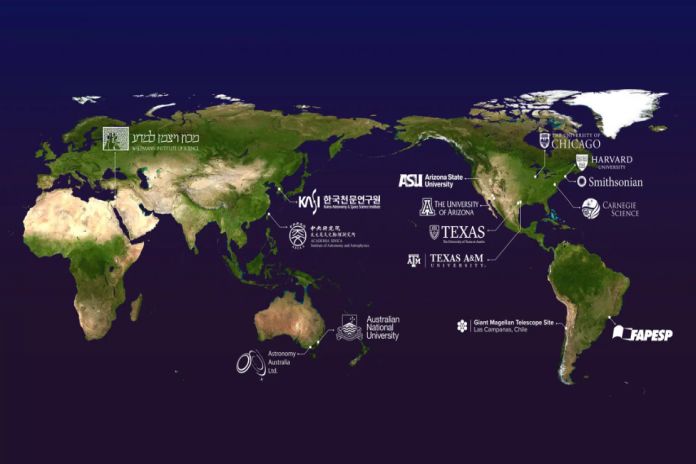- Through ASIAA, Taiwan joins Australia, Brazil, Chile, Israel, South Korea, and the United States in building one of the world’s largest and most powerful telescopes
PASADENA, USA – The Giant Magellan Telescope on Tuesday, February 20, 2024, welcomed Academia Sinica Institute of Astronomy and Astrophysics (ASIAA), a distinguished Taiwanese research institute, into its international consortium. ASIAA’s inclusion expands the consortium to 14 international research institutions, underscoring Giant Magellan’s significance to the global astronomy community and the consortium’s commitment to prioritizing global collaboration for the advancement of science.
“We are thrilled to welcome ASIAA into our international consortium of distinguished partners,” said Dr Walter Massey, Board Chair of the Giant Magellan Telescope.
“Together, our consortium combines worldwide science expertise and engineering acumen to create a project that benefits all walks of research relating to the universe. This collective investment in the Giant Magellan Telescope is a testament that science can transcend boundaries and bind humanity together for good.”
The astronomical research and instrumental development capabilities in Taiwan have received international recognition. ASIAA will contribute expertise in areas such as low noise and compact detector electronics, precision detector characterization technology, precision laser cutting technology, and many others. These contributions will prove invaluable once the telescope is commissioned in the early 2030s.
“ASIAA is delighted to be a part of the Giant Magellan Telescope consortium, and the Taiwanese scientific community is prepared to contribute its expertise while also benefiting from the wealth of knowledge within the consortium,” said Dr Ue-Li Pen, the director of ASIAA.
“Joining one of the thirty-meter-class telescopes has been a long-term aspiration for Taiwanese astronomers, and Giant Magellan is considered the most suitable project for this endeavor. The collaboration between ASIAA and the Giant Magellan Telescope establishes a robust foundation for astronomical research in Taiwan, with a particular emphasis on nurturing the development of new generations in the field. We also anticipate that this project will deepen collaboration between Taiwan and the six other countries in the consortium.”
Construction of the telescope advances rapidly in the Chilean Atacama Desert and in labs around the world. Over the past year, fabrication commenced on the seventh and final primary mirror in Arizona, while manufacturing of the 39-meter-tall mount structure began in Illinois. Progress includes completion of the first of seven mirror covers in Germany, and near completion of the telescope’s first adaptive secondary mirror in France and Italy. Other advancements were made on a suite of high-resolution imagers and spectrographs in Arizona, Australia, California, Massachusetts, South Korea, and Texas.
These optical technologies will enable the Giant Magellan to boast a remarkable tenfold increase in resolution compared to the Hubble Space Telescope and deliver up to 200 times the power of today’s best telescopes. The breakthrough technologies will empower scientists worldwide, offering unparalleled insights into the evolution of the universe, the origins of chemical elements, and the discovery of life on distant exoplanets for the first time.
News of ASIAA’s inclusion into the Giant Magellan Telescope’s international consortium was celebrated by elected officials in the United States dedicated to scientific advancements, democratic values, international partnerships.
US Senator of Arizona and former NASA Astronaut Mark Kelly emphasized how science collaborations can strengthen international relations. “Arizona has long been a leader in astronomy and optical research, and thanks to key contributions from the University of Arizona and Arizona State University, the Giant Magellan Telescope will lead the way making the next generation of discoveries in astronomy,” said senator Kelly. “We welcome the newest collaborators from Taiwan to the Giant Magellan consortium and look forward to strengthening ties between Arizona and Taiwan through our shared commitment to democracy, education, and innovation.”
US Congressman of Texas and chairman of the House Committee on Foreign Affairs Michael T. McCaul, also emphasized the significance of supporting large international research initiatives.
“I’m glad our friends in Taiwan have joined this important project, which includes top-notch research institutions like Texas A&M and The University of Texas,” said Congressman McCaul. “The Giant Magellan Telescope will be a ground-breaking observatory that will expand our knowledge of the universe and enable the US to maintain its dominance in ground-based optical and infrared astronomy.”
ASIAA joins Arizona State University, Astronomy Australia Ltd., Australian National University, Carnegie Institution for Science, Harvard University, Korea Astronomy and Space Science Institute, São Paulo Research Foundation, Smithsonian Institution, Texas A&M University, The University of Texas at Austin, University of Arizona, University of Chicago, and the Weizmann Institute of Science in building the Giant Magellan Telescope.







